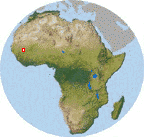 Bafing River region, SW Mali
Bafing River region, SW Mali Bafing River region, SW Mali
Bafing River region, SW MaliThis region came to anthropological attention when Kortlandt (1983) suggested that it was the most arid habitat in which chimpanzees live. Stimulated by this, I did a brief survey of the area (Moore, 1985) while searching for a savanna chimpanzee study site. I suspect it is the most arid chimpanzee habitat; while it may not have the lowest rainfall, rapid runoff due to lateritic plateaus and dry harmattan winds off the Sahel leave very little surface water or humidity. I elected not to pursue research there because there has been widespread hunting of nonprimates, leaving the chimpanzees in an ecologically disturbed setting. However, since my survey a National Park has been established in the catchment of the Manantali Dam (one of the largest in the world, completed in the mid-80s) and the area remains a potentially significant one for studying chimpanzee adaptation to arid habitats. The materials here may be useful for anyone interested in visiting the region.
In the early 1990s, Jean-Michel Pavy did an extensive survey of the area (focussing on chimpanzees) and when I last communincated with him was planning to participate in planning and implementation of the Park's management. I don't know of any publications or where he is now; I believe he wrote a project summary for WCI that may be available. In the mid-90s, Peace Corps volunteer Andrew Webster did some chimpanzee survey work in the area and may be pursuing that.
| Name: | Bafing River and SW Mali; catchment of Manantali Dam |
| Location: | Soutwest Mali, roughly 12-13° N, 10-11° 30' W |
| Status: | An area surrounding the catchment of the Mananatali dam, extending as far south as Bafing Makana, was recently created a National Park; otherwise most of the area is unprotected |
| Area: | Chimpanzees are probably distributed (thinly) over thousands of square kilometers |
| Altitude: | varies greatly m |
| Temp: | --- °C |
| Rainfall: | Region lies between 1100mm - 1300mm isohyets (PIRT, 1983); rain largely restricted to July through November. |
| Vegetation: | Soudanien or soudano-guineen. Dominant trees on two plots I surveyed included Pterocarpus erinaceus, Combretum spp., Bombax costatum, Acacia machrostachya, Terminalia laxifolia, Daniellia oliveri, Gardenia erubescens, and Detarium microcarpum; others listed by PIRT (1983) include Lannea microcarpa, Isoberlinia doka, and Vitellaria paradoxa. In many areas open grasslands on thin-soiled plateaus are cut by thin riverine strips; elsewhere it is open woodland (see habitat photos). |
|
Human influence: |
The entire region is thinly settled. People rarely hunt primates (but see Conservation below) but hunt everything else and animals are scarce. Disturbance ratings -- 3, 2, 2, 2, 2 |
|
Closest village: | Low density, throughout region; isolated farms (nests seen within 100m of fields) |
|
Species studied: | P. t. verus |
|
Population density: | Unkown but probably comparable to nearby Mt. Assirik -- 0.08 - 0.1 individuals per km2 If evenly distributed across the region (extrapolating from survey route) total population in western Mali would be 600-1,000 (in 1984) |
| Fauna: | 1984 survey confirmed baboons (P. papio/anubis), vervets (C. aethiops), patas (E. patas) and galago were reported. Primates are only rarely hunted, but nonprimates have been hunted to very low numbers. |
|
Study period: | Survey of about 3 weeks in December, 1984 |
| Habituation: | None |
|
Research presence: | None |
| Conservation: | Chimpanzees are not traditionally eaten, but skins and tissues are used in traditional medicine. If 20-35% of chimpanzees are reproductive females and the interbirth interval is 5 years, between 24-70 infants would be born in Mali annually. The 3 skins I saw in Bamako in one month, in one market, thus represented 4-12% of annual production. Assuming several other cities have markets and that skins are fully used in less than a year, this traditional use alone places a heavy demand on the chimpanzee population. |
|
Current research: | None |
| Methods: | Nest survey (no transects; not quantitative) |
|
Contact person: | None (Jean-Michel Pavy??) |
| Habitat photos | --- |
| Maps | A 1:1,000,000 scale map of the region. |
| Aerial photos | Detailed satelite imagery and analysis available in PIRT (1983) (to the extent that report is available; I was able to consult a copy at TAMS in New York). |
| Bibliography |
|
| Miscellaneous | Related links |